#saucer shaped ufo
Text

The most popular saucer shaped UFO that has become an iconic symbol of the ufology field is this one.It seems that many races have embraced this design in different sizes.Notice how the crashes throughout the history of this alien craft has been primarily on this shape.We no longer consider this to be a secret or a matter of National Security.If you are part of this community you already know that the government knows so much more about this technology after they have been collecting these saucers and reverse engineering with the help of course of some of these extraterrestrials .We also know that the Nazis were deeply involved with these saucers and its technology perhaps not completely clear back then ,but many ended up in the USA. and we’re allowed to continue experimenting with extraterrestrial saucers.Again no secret there.It never ceases to amaze me how we keep talking about The Roswell crashes ,but never reporting of the hundreds of crashes that have occurred due to our government shooting them down until recent times and the discovery of recent alien technologies.Now that is kept secret .Well ,as long as whistleblowers keep coming forward with information,risking their lives in the process to make us aware of the latest events,we must be deeply grateful for these courageous individuals and pray for their safety and that of their families. Well, as I said before the show must go on .Peace to all of you who contribute daily to this topic.Words and sketch by Sergio GuymanProust.
0 notes
Text
triangle is easily the best ufo shape
#also shoutout to boomerang and cylindrical#i like the classic saucer shape but its too mainstream it's like very 50s meanwhile the triangle is like 80s/90s sightings#like the belgian ufo wave which were triangles!
5 notes
·
View notes
Text

They originally came here to try to investigate our chemtrail technology, and got increasingly frustrated when all their samples turned out to just be water ice with trace amounts of jet exhaust.
Alien Theories [Explained]
Transcript Under the Cut
[Cueball is standing. There are two spaceships shaped like flying saucers in the sky above him. A voice comes from the spaceship on the right.]
Cueball: But you know aliens exist!
Voice from spaceship: Yeah, but these reports describe fast-moving objects with capabilities far beyond anything we possess!
Voice from spaceship: It would be foolish not to investigate!
[Caption below the panel:] Annoyingly, the aliens turned out to be really into UFO conspiracy theories.
492 notes
·
View notes
Text

Mount Shasta
There’s a well-known legend that says that somewhere deep beneath Northern California’s 14,179-foot-tall Mount Shasta is a complex of tunnels and a hidden city called Telos, the ancient “City of Light” for the Lemurians. They were the residents of the mythical lost continent of Lemuria, which met its demise under the waves of the Pacific (or the Indian Ocean, depending on who you ask) thousands of years ago. Lemurians believed to have survived the catastrophe are said to have settled in Telos, and over the years their offspring have been sporadically reported wandering around the area: seven-feet-tall, with long flowy hair, often clad in sandals and white robes.
Lemurians aren’t the only unusual figures said to inhabit this stand-alone stratovolcano, easily seen from Interstate 5, about 60 miles south of the Oregon border. Mount Shasta is believed to be a home base for the Lizard People, too, reptilian humanoids that also reside underground. The mountain is a hotbed of UFO sightings, one of the most recent of which occurred in February 2020. (It was a saucer-shaped lenticular cloud.) In fact, the mountain is associated with so many otherworldly, paranormal, and mythical beings—in addition to long-established Native American traditions—that it’s almost like a who’s who of metaphysics. It has attracted a legion of followers over the years, including “Poet of the Sierras” Joaquin Miller and naturalist John Muir, as well as fringe religious organizations such as the Ascended Masters, who believe that they’re enlightened beings existing in higher dimensions. What is it about this mountain in particular that inspires so much belief?
“There’s a lot about Mount Shasta, and volcanoes in general, that are difficult to explain,” says Andrew Calvert, scientist-in-charge at the California Volcano Observatory, “and when you’re having difficulty explaining something, you try and understand it.” Calvert has studied Shasta’s eruptive history since 2001. “It’s such a complicated and rich history,” he says, “and Shasta itself is also very visually powerful. These qualities build on each other to make it a profound place for a lot of people—geologists, spirituality seekers … even San Francisco tech folks, and hunters and gatherers from 10,000 years ago. It’s one that can have a really strong effect on your psyche.”
Mount Shasta is one of the most prominent of all the Cascade volcanoes, an arc that runs from southwestern British Columbia to Northern California, and includes Washington’s Mount Rainier and Oregon’s Mount Hood, among others. “It’s so steep and so tall that it even creates its own weather,” says Calvert. This includes the spaceship-looking lenticular clouds that tend to form around the mountain, created, he says, “by a humid air mass that hits the volcano, and then has to go up a little bit to cool off.” But they only contribute to Shasta’s supernatural allure, along with its ice-clad peak, steaming fumaroles, and shape-shifting surface that’s being constantly broken down and rebuilt by ice, water, wind, and debris. The mountain also sits about 15 miles or so west of the standard arc line of the other Cascade volcanoes—a move that took place about 700,000 years ago. “We don’t really have a good explanation for why it moved out there,” Calvert says, a statement that seems to make Mount Shasta’s mysteries appear more otherworldly by the minute.
The Mount Shasta spiritual legacy goes far deeper than contemporary myths and sightings. For Native Americans in particular, the mountain is a sacred place, straddling the territories of the Shasta, Wintu, Achumawi, Atsugewi, and Modoc tribes, which can date their lineages back to a time when eruptions actually took place there. (Its last eruption, says Calvert, was a little over 3,000 years ago.)
There’s Something About Mount Shasta
42 notes
·
View notes
Text
the fact that the "flying saucer"-shaped ufo prevalent in modern popculture & ufo conspiracy theories traces back to one (1) single misquote is so wild to me. like one pilot saw some strange lights one time, described them to a local paper as "moving like a saucer would if skipped across water," the paper called the lights "saucer-like," then another paper picked it up, and another, and soon you were getting shit like this:

and it just kept fucking spiralling until "flying saucers/discs" became a thing. like that's it. that's where that imagery originates from. a newspaper misquote from 1947
93 notes
·
View notes
Note
if aliens came down and gave you your own personal customized ufo what would you want it to look like

^ interior is like this fucking thing
itd be traditional flying saucer shape, with the multicolored lights around the edges and seamless metal door. it spins like the mars attacks suacers
26 notes
·
View notes
Text

ROSWELL ALIENS- NEW MEXICO
Finally finished all 50 State Cryptids! Time to start putting them together into a book!
I always have a bit of a quandary whenever I showcase an alien as a “State Cryptid”. For many people the term “cryptid” typically refers to unknown Earthly animals. But over time this blog has evolved into more of an overall tour of speculative creatures in American pop culture and folklore where the lines between “natural animal”, “supernatural entity”, and “extraterrestrial” become very blurry. I’m also much more interested in the history behind these sightings than the classification of each creature, or even whether it plausibly exists at all. Plus I’ve already featured several extraterrestrials already such as the Pascagoula creatures, the North Dakota Meccano-Mummy, and the Grays that allegedly abducted Barney and Betty Hill.
June 14, 1947- Rancher W.W. “Mac” Brazel and his son were driving on their property 80 miles outside of Roswell, New Mexico when they came upon “a large area of bright wreckage made up of rubber strips, tinfoil, and rather tough paper, and sticks.” What was it? They had no idea.
Initially unsure about what to do with the strange find, Brazel collected some of the debris a few days later and drove it into Roswell to give to Sheriff George Wilcox. The sheriff, equally perplexed, contacted the nearby Roswell Army Airfield’s 509th Composite Group. They sent a team out to the desert to collect the remaining debris and ascertain what it was. A few days later Major Jesse Marcel made a statement to the local paper about the incident. Though he didn’t explain exactly what the object was, headlines claimed the army had captured a “flying saucer”.
Flying saucers were in the news a lot that year. On June 24th, 1947 amateur pilot Kenneth Arnold reported seeing an airborne, disk-shaped vehicle near Mt. Rainier in Washington. Later, Navy seaman Harold Dahl claimed he had seen a whole group of the strange objects on June 21st near Puget Sound. Soon people were sighting flying saucers everywhere. Much of this hysteria was fueled by fears of the growing power of the Soviet Union and worries about what secret experiments they might be conducting. Paranoia about unknown Russian flying vehicles soon turned upwards beyond the boundaries of Earth as people began to speculate that flying saucers actually came from other worlds. These mysterious objects were labeled UFOs- Unidentified Flying Objects- by the US military and the term quickly caught on in popular culture. Though UFO originally just meant an unknown aerial object, with no indication of origin, it became synonymous with extraterrestrial spacecraft.
Eventually the army explained that the debris found near Roswell had come from a downed weather balloon. But such a prosaic explanation did not stick with the public. The idea that creatures from outer space had crashed on Earth had firmly taken hold, and a good number of people believed that this “weather balloon” story was just a flimsy cover-up. It certainly didn’t help that the government was tight-lipped about many of its programs out of fear that the Soviets might get wind of them.
It turns out, though, that the weather balloon story was actually close to the truth. In the late 1940s the government began Project MOGUL, in which massive balloons equipped with sensitive detection instrument were launched high into the ionosphere to look for signs that Russia was testing nuclear weapons. One of these balloons had fallen out of the sky, crashed on Brazel’s ranch. Not wanting to reveal their secret project, military officials had felt it was better to let the “alien spacecraft” idea percolate in the popular imagination instead.
A decade later In the 1950s rumors cropped up that people had seen government agents collecting alien bodies in the New Mexico desert. These stories were soon conflated with the Roswell crash legend, leading to conspiracy theories about frozen alien corpses preserved in secret government hangers. For many years any secretive government sight was rumored to have “aliens in the freezers”. Eventually accusations settled on Area 51, a classified military base in the Nevada desert.
These reports too had a more down-to-Earth explanation, though. Investigations revealed that the “alien bodies” had actually been special crash dummies fitted with sensors and dropped from airplanes by the Airforce to test the effects of high-altitude parachute drops. Like Project MOGUL, these tests had been hidden behind a thick veil of secrecy which did little to dispel the rumors.
As for Area 51, though the government denied its existence for decades despite clear evidence that it existed, it was officially confirmed in 2013 as a base for testing experimental aircraft such as the U2 spy plane, the Archangel-12, the SR-71 Blackbird, and others. No word on frozen alien corpses, though. By the way, the name “Area 51” is more of a pop culture term. The base is typically just called “Groom Lake”, “Homey Airport”, or simply the “Nevada Test and training Range” by the CIA.
The Roswell Aliens story gained a major surge in popularity in the 90s with shows like “The X-Files” and “Dark Skies”, movies like “The Arrival” and “Independence Day”, and comic books like “Roswell, Little Green Man” by Bill Morrison. There was even a 1995 psuedo-documentary called “Alien Autopsy: Fact or Fiction” produced by the Fox Network and hosted by Star Trek actor Jonathon Frakes. It allegedly showed vintage footage of the dissection of an alien corpse from the Roswell crash. This video was eventually revealed to be a hoax, with the corpse actually a rubber dummy stuffed with jam and animal organs from a butcher.
For my depiction of the Roswell aliens, I wanted to get away from the typical images of corpses lying on dissection tables or floating in preservative-filled tubes. I also wanted to avoid the trope of aliens as malicious, terrifying invaders like in Independence Day or any number of B horror movies.
Instead, I chose to portray them as normal beings adapting to a new life on Earth. Here we see one of the aliens recovered from their crash with the help of a wheelchair and prosthetics. I’ve imagined them setting up a new life for themselves in New Mexico, just trying to keep to themselves. They’ve taken a keen interest in their new home, evident in their collection of local plants like ocotillo and yucca. They’ve also made friends with many locals, including Indigenous communities, evident here in the “Singing Mother” figure on the table. These figures were first created in 1964 by artist Helen Cordero of the Pueblo de Cochiti, a community of the Keres Pueblo peoples.
As immigrants themselves, the Roswell Aliens also feel a kinship with the many other people that have moved to New Mexico from other countries. This is reflected in the alebrije they got from a Oaxacan-born artist.
REFERENCES
The Roswell UFO Festival!
A Smithsonian article on the crashed MOGUL balloon
An article from History.com about the Roswell incident
An article from the Chicago tribune about the high-altitude dummies that were mistaken for alien bodies.
A Space.com article about Area 51
An article about the infamous "Alien Autopsy" pseudo-documentary
Another article about the "Alien Autopsy" film
45 notes
·
View notes
Text

On this day:
ROSWELL INCIDENT
On July 2, 1947, the most debated UFO fell from the skies over Roswell, New Mexico. Late at night, Dan Wilmot and his wife watched "two inverted saucers faced mouth to mouth" flying above their house for almost a minute. The luminous craft, tracked by military radar, "flashed through the atmosphere as a thunderstorm ripped through the night. The next morning, Mac Brazel, a ranch foreman, rode out on horseback to inspect his fences for damage. He found a half-mile-wide path of unidentifiable debris. The material was a dark, pliable, metal foil unlike anything he had ever seen. Scrunching it up made no impact. It would spring back to shape. Lightweight and durable, the scraps, some with mysterious markings, could not be burned or further broken.
Brazel showed samples of the wreckage to several neighbors and eventually called County Sheriff George Wilcox, who in turn notified the Roswell Army airfield. Within the week, radio stations were carrying the story of a crashed flying saucer, and newspaper headlines carried photos of army personnel posing with the silvery debris. The story was soon "corrected" by the military, which said that the UFO was a crashed weather balloon. Following the switch came civilian reports of more substantial fragments and four small, gray-skinned alien corpses. A local mortician received a request for child-size coffins.
Over the decades prominent UFO investigators have collected testimonials from local civilians and been stonewalled by others who were sworn to secrecy. Claims of heavy-handed threats and military involvement added fuel to the controversial topic. Brazel changed his story to the official version and left town. Sheriff Wilcox clammed up. Frustrated by lack of information, researchers continued to hunt for records for the next half century, only to be foiled by having the documents they were seeking unexplainably destroyed.
Text from: Almanac of the Infamous, the Incredible, and the Ignored by Juanita Rose Violins, published by Weiser Books, 2009
15 notes
·
View notes
Text
An interesting UFO sighting over NYC.
19 notes
·
View notes
Text
Findings from watching the season two opening. Here be spoilers if you haven’t seen it, begone all who seek to avoid those.

Crowley climbs up the rock (and does not look like he enjoys climbing much). Does that mean demons can’t fly? Crowley in particular can’t fly?
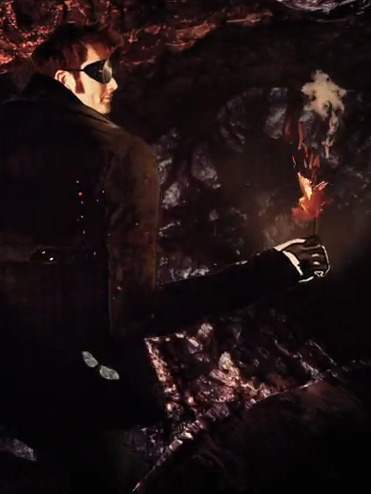
There is a moth (butterfly) that starts flying with Crowley and Aziraphale when Crowley lights the match. It’s the first creature that accompanies them. Is it important?

The fuck is this thing. I thought it’s an elephant first? With a trunk? But it’s on fire. Could just be a rock? Whatever it is, the angel with the box (Gabriel?) spawns right behind it. I would say portal to Hell, but angels don’t commonly come out of those. Or do they now? Anyway mysterious fiery thing.
There’s also a bunch of animals in the background of this setting. They seem to be mostly sheep and goats. And there’s huge bones/skeletons. Dinosaurs are fictional in the Good Omens verse, though. (Something about the dinosaurs are a joke thing? Please let it be something about dinosaurs being a joke, I love this bit.)
It’s raining fire and the poor goats and sheep get torched. :( Looking pretty apocalyptic for a season that (maybe) isn’t about the end of the world this time!

There’s the pickled herring from the spoiler/bts pics! And this person looks like Hastur IMO. “Everyday” apparently already died; it’s on a tombstone. What is the person in the back (behind the herring barrel) carrying? A miniature airplane? A rocket launcher? A big camera?
And THEN there’s the lamp with a face and feet guy, walking in front of the person with the headscarf. WTF is with lamp with a face guy. Lamp with a face guy even has a smaller lamp attached to his arm. I do not want to meet lamp with a face on a dark graveyard!
There are some more spooky characters joining the procession as it goes underground. What’s up with red head and a lamp on a stick guy for example?
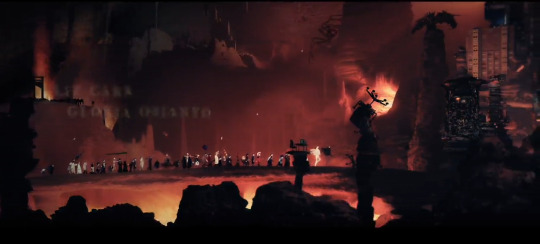
Lovelovelove Hell with the magma and the giant spider and the office chairs on rocks (some of them upside down). Giant pentagram in the background that seems to be spinning! I loved the basement office hell vibe they used for Hell in S1, but this fiery Hell looks so cool. Creature with bat wings perching on top of a rock! Great vibes, very hellish.
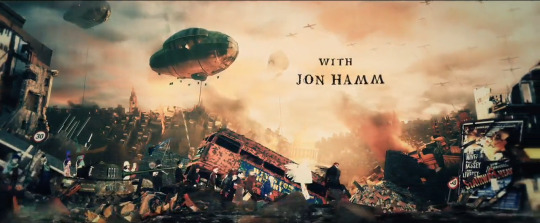
London during the airstrike has a cool blimb, a tank, lots of wreckage, is apparantly a 30 zone, so no speeding, and there’s an ad for Stairway to Heaven. Seems like a play or a movie maybe?
Aziraphale and Crowley with their wings out walk in front of a bus with “wings for victory” written on the side. And then an aircraft throws a bomb on them.

It is raining rabbits in the entryway to the magic show theatre, and there’s person sized and shaped rabbit in the audience. Is it Harry the Rabbit?

Lots of interesting head dresses in the people following after Crowley here, and there’s Beelzebub. They’re being led to meet Aziraphale in his magic uniform, now upgraded with a cape! (He should have worn the cape to Adam’s party, capes are cool.)
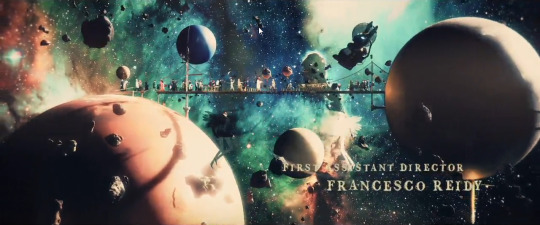
Space! Spacespacespace! Look at the planets and stars! Also the tank, it’s still here. And there’s... a rabbit astronaut? With glowing eyes?
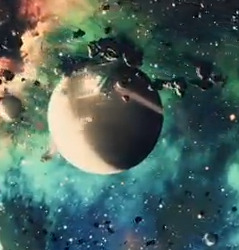
Little UFO crossing in front of that moon/planet! Looks a bit like the flying saucer from season 1.

Thy kingdom airways lol! And it’s raining hearts! On Aziraphale and Crowley on the bookshop roof.
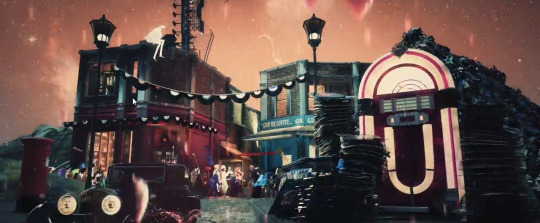
“Give me coffee or give me death” is a very metal slogan for a coffee shop. And there’s lots of music themed stuff in the street. There’s a jukebox, a pile of records behind it, that decoration between the street lamps looks like vinyl records cut in half strung up? And the Bentley is there, probably blasting Queen. :D

The skycrapers are elevator shafts. The one in the middle has an angel in it, riding down. Down to Hell? Ding!

It’s the Dirty Donkey! And the movie theatre is called “The Arrival”. It’s screening today! That’s very clever, wonder if the opening will change with the different episode titles? :) Also, there’s the image from the box the angel is carrying again, on the film posters for The Arrival. Can’t tell what it is.

Look at them all walking into the light! They’re going to be enlightened! Or something. But it is a very bright light! Lighthouse! It’s also covered in scrap and junk nearly to the top. Whatever that may mean. (Guys don't walk into the light, no!)
My friends, I am really looking forward to stop waiting and see what this is all about!
#good omens#good omens season 2#s2 opening title#in which I definitely watched this too often#should probably go to bed#but there's so much to see!#what's the mystery light they all walk into#p+a
95 notes
·
View notes
Text
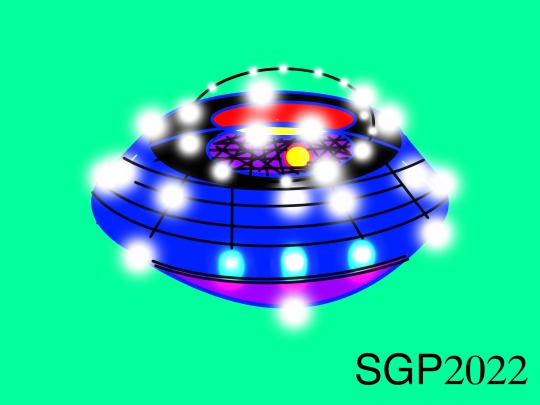
Everyone has seen that poster in the X Files I WANT TO BELIEVE. Well, I think we are past that stage.The evidence keeps piling up, credible witnesses from airline pilots ,to police officer,to engineers,to your neighbors.And you of course. At the other end of the spectrum we have the government and its agencies the Pentagon ,NASA,ready to cover up any sightings with disinformation,an airbrush in the art department of NASA, to quietly erase any signs of extraterrestrial life ,all in the holy name of National security. Well, by now we know how these brainwashed government drones go around the globe picking up any debris whenever there’s a crashed UFO. Well, this saucer was sighted back in 1968 in Arizona.The original sketched appeared in a local paper but it was printed so small that went practically unnoticed, let’s just say that perhaps was considered a run of the mill alien craft a person sent in,but fearful of the consequences decide to keep it anonymous. Words and sketch by Sergio GuymanProust.
#ufofiles#ufoart#ufo#words and sketch by sergio guyman.#saucer shaped ufo#ufo sightings#ufo phenomenon#aliens and ufos
1 note
·
View note
Photo
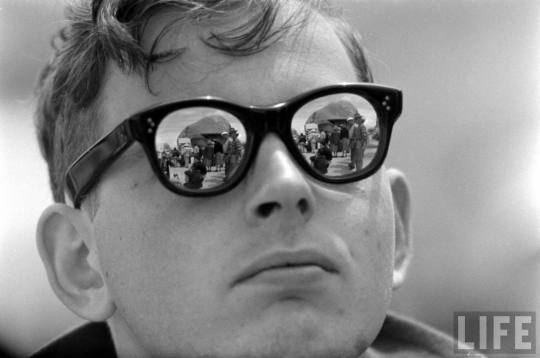
And, now from the archives of Life Magazine, a funky flashback to the 1950s Flying Saucer Conventions.
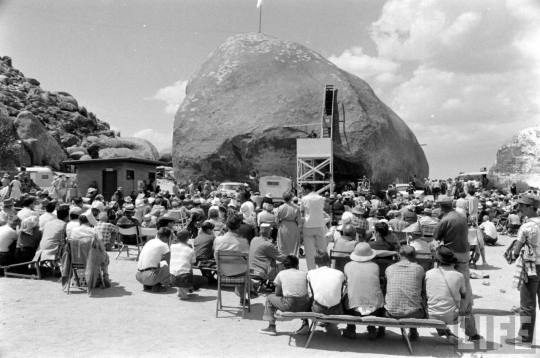
These B&W photos document the convention, from the quirky attendees and their campsites, the UFO memorabilia, the bustling scene that once surrounded this now lonesome boulder and best of all, a look inside the secret home that once lay beneath the giant rock.

So, how did a man come to live under a rock in the California desert?
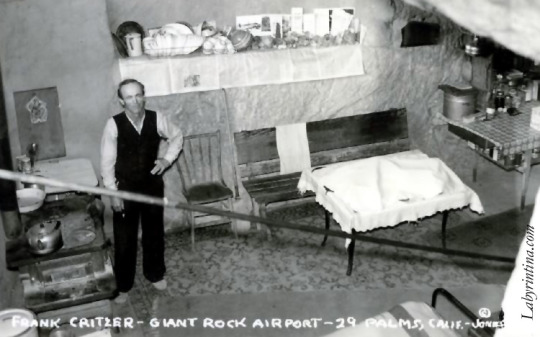
In the 1930s, an eccentric German immigrant called Frank Critzer, dug out a subterranean home under the giant rock. He lived there alone, isolated from society with nothing but a radio antenna on top of the rock to stay connected to the outside world.
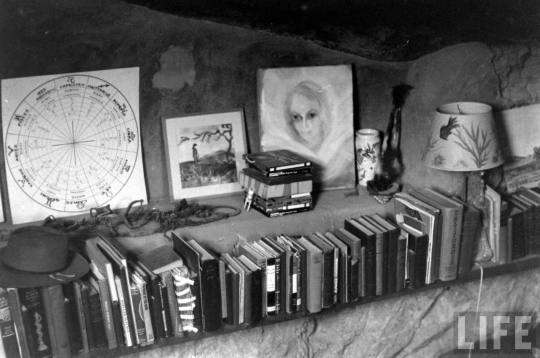
In 1942, the police came to investigate rumors that he was a Nazi spy and Frank died from a self-detonated dynamite explosion in his own bunker. They thought that he was a spy because of his radio antenna. But, he was just a radio enthusiast who wanted to be left alone.
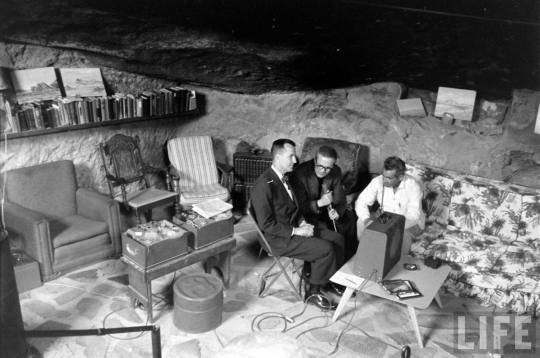
After his death, Frank’s only friend, a former aircraft inspector named George Van Tassel, became the giant rock’s new tenant in 1947.

In addition to being an aviator, he also liked to dabble in the telepathic channeling of alien life.

In a few years, George went from living a simple life with his family in the rooms Frank Critzer had dug out under the Giant Rock, to building his own restaurant on the site, a small airstrip, and an extra-terrestrial research center.

The UFO center would play host to his annual Giant Rock Spacecraft Convention, attracting more than 11,000 people at its peak.
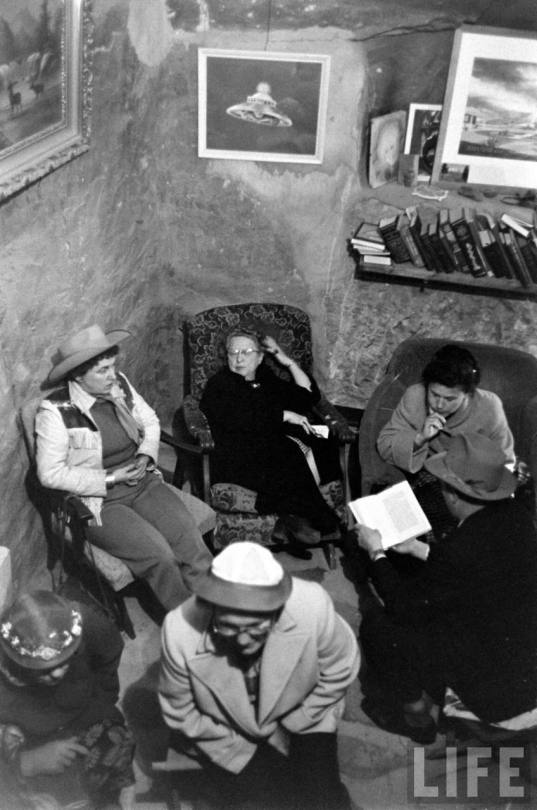
Tassel’s onsite research center, nicknamed “the Integratron“, was believed by many to have some pretty special powers–
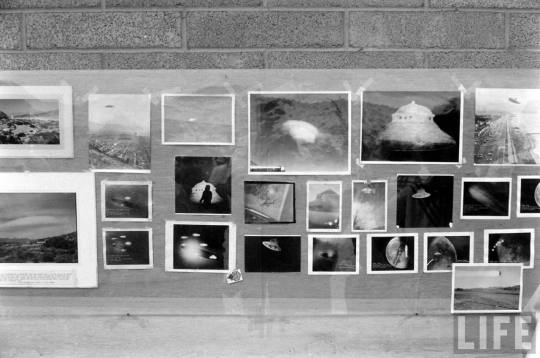
Including ‘anti-gravitational and time traveling capabilities provided by extra-terrestrial life on Venus.’

For nearly 20 years it became the dream pilgrimage of every UFO nut enthusiast in America.

Let’s take a look at the UFO style of the day, beginning with the wonderful hats.
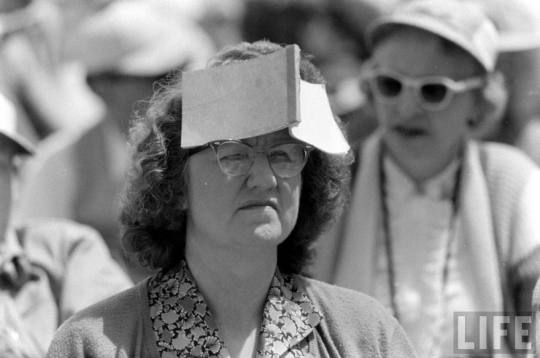
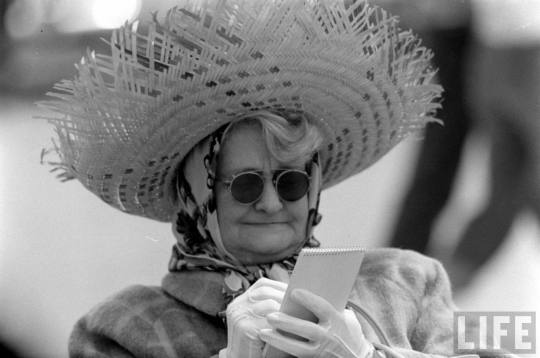
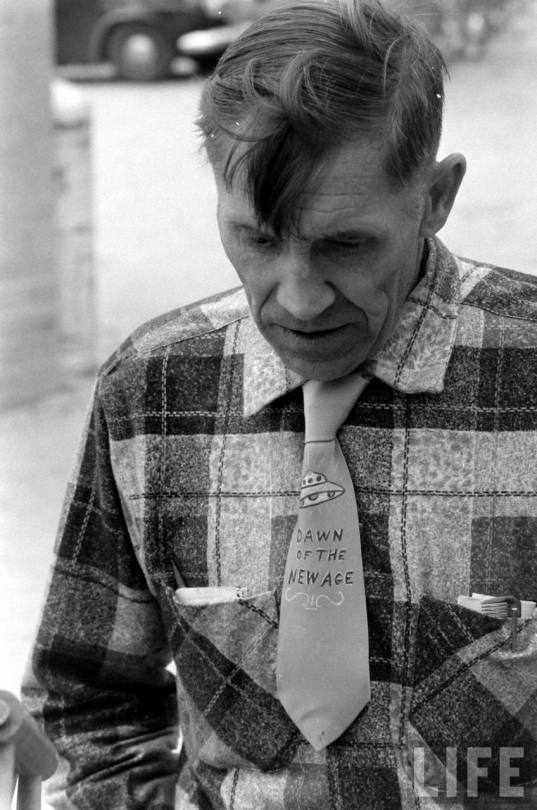
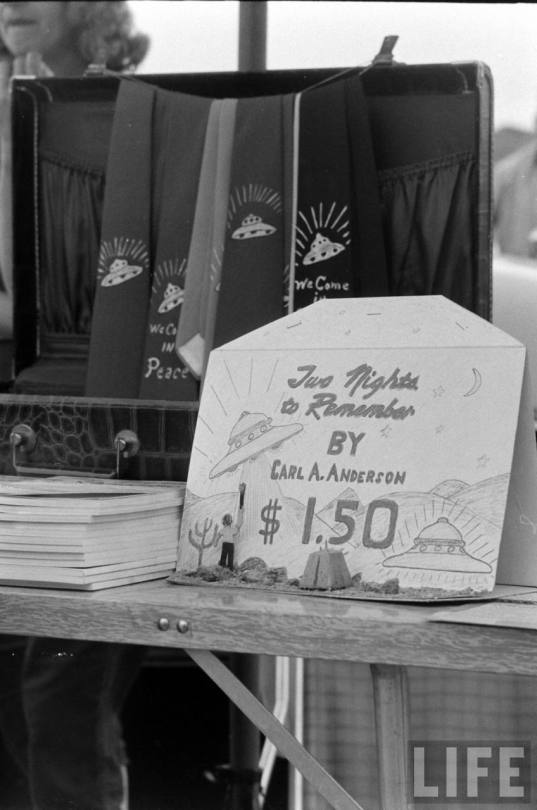
And the flying saucer accessories.
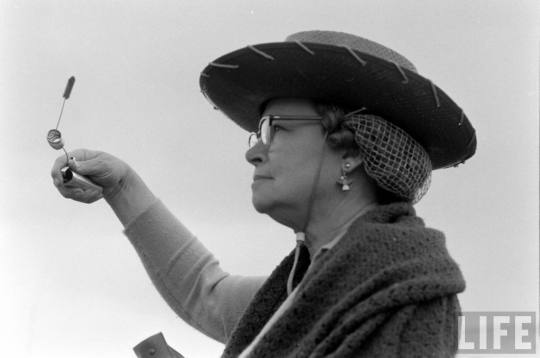
What the hell is that?

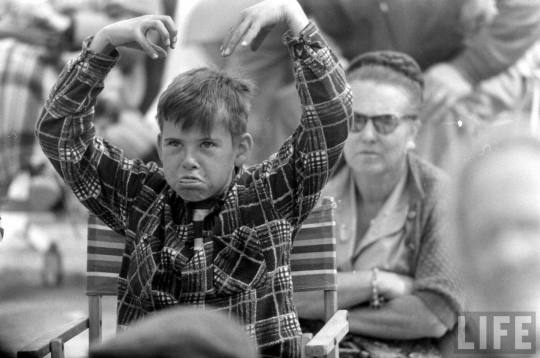
It was also something the whole family could enjoy.

The dome-shaped ‘Integratron Center’ still stands near the giant rock, and after Tassel’s death in 1978 there were plans to turn it into a disco.

Instead, the new owners turned it into an off-beat tourist attraction offering “sound baths,” claiming it to be “the only all-wood, acoustically perfect sound chamber in the U.S.”

It was built from instructions from Mars. I don’t know, except for the bus, clothes, & lack of hats, the people are pretty much the same.
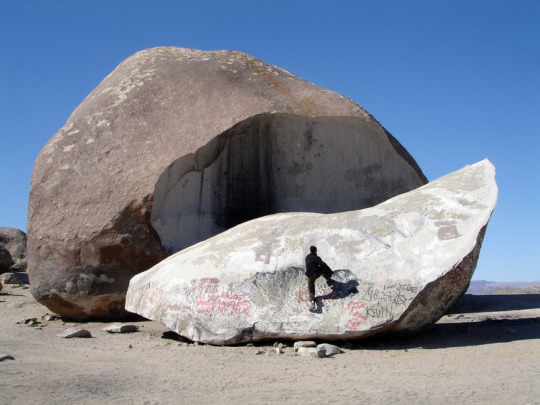
As for the rock, in the year 2000 it fractured in two when a large piece broke off, revealing its white interior granite. Sadly, it’s covered in graffiti.
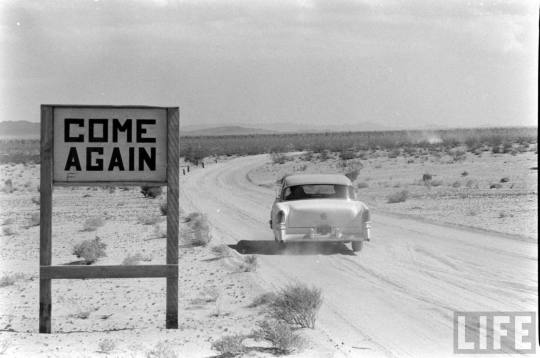
https://mojaveproject.org/dispatches-item/giant-rock-space-people-and-the-integratron/ // messynessychic.com // life magazine
205 notes
·
View notes
Text
Waking Dreamland
Rated T // 4000 words // Read on A03
Angst (oh so much angst) with a happy ending! During my last rewatch I stayed up until 2am crying over the handful of sunflower seeds that Mulder gives Scully when they say goodbye (totally normal behavior right??), and thus this fic was born.
tagging @today-in-fic @ao3feed-msr
Dreamland AU - When Mulder is unable to switch back into his original body, Scully returns to Washington and he remains in Rachel, Nevada. They both try to build new lives for themselves, but how can they endure without each other?
He grows a beard. It’s the wrong color, but thicker and softer than the one he tried to grow in high school, and he’s surprised by how much he likes it, by how much it helps; it hides the unfamiliar chin and gives him something to look at in the mirror besides the eyes surrounded by laugh lines he didn’t earn, the nose that was never broken in a fight with Bobby Scortino behind the gym in fifth grade, the mouth that has never felt the sweet, trembling warmth of her breath.
This other man’s body hangs on him like an ill-fitted suit, soft from years behind a desk, but the knees are in decent enough shape for him to ease into a running routine that may someday catch up to what his old body could do. He lifts weights at the rec center, slowly replacing the beer gut with lean muscle; and though he knows it will never be the same, at least it’s a change he can control. Exercise helps with his anxiety, which unfortunately didn’t get left behind, unlike his weird little toe and the gunshot scar below his clavicle that he still startles to find missing each morning in the shower.
He joins a basketball league, even starts coaching a couple of youth baseball teams. There’s a girl named Dreama on the Tween Team, a little redheaded shortstop who always has her science textbook in her gym bag and never lets him get away with anything. He feels a near-painful whelming of hope for her, and endless indulgent pity for the gangly, dark-haired boy who trails along after her everywhere she goes, trying to impress her.
If being a Man in Black is hard, then quitting is somehow even harder; they don’t usually let men of his (well, Morris’s) position just hang up their flashy-things and walk out the door. He suspects they only let him get away with it because of the divorce, and because he stays close enough to the base that they can monitor him—dark cars with bland men parked in front of his apartment, a clicking any time he picks up the phone. Not that he has many places to go, not that he has anyone to call. He lingers only on the periphery, keeps only the most superficial relationships, glancing off of other people’s lives like light off a soap bubble.
Joanne kept the house and the kids, of course. He hears through the grapevine that Chris got early acceptance to UCLA, and that Terrance wants to become a screenwriter. Their new stepdad works in the same division that was in charge of faking the moon landing (before NASA managed to pull off the real one) so the kid will probably have an “in” at any studio he likes. He sees Joanne in town sometimes, at the market or the post office or the video store, and she is always smiling. He doesn’t approach her.
Sometimes the best thing you can do for someone is just get out of their way.
He gets a job, of all places, at the Little A’le’inn, slinging Alien Ales and Saucer Burgers to townies and tourists alike. It’s not a great job, but he’s had worse; and at least he gets to keep his ear to the ground for any good UFO gossip, even if it’s just the bragging of the test pilots and not hints into the dark heart of the mystery that consumed him for so many years. He has had to mourn for the answers he will truly never find, now, and the irony of being scant miles from the conspiracy theorist holy grail while himself being resigned to more earthly concerns is not lost on him.
He works, he works out, he endures. He slowly accepts that he will live and die in this body, in this prison of flesh that creaks in all the wrong places, in this life he tripped and fell into while it was already in motion. It’s a life sentence, and there is not even the hope of parole on the horizon.
The constant flow of UFO-worshippers through this bizarre neon honkytonk Mecca has one advantage: he can keep in contact with the Lone Gunmen. All his phone and email correspondence is being monitored, so they’ve set up drop points and communication systems in what the boys colorfully refer to as “meatspace” to get around it. There is a loose tile behind the door in the men’s room with a crack on one side and a hole behind it that they use to exchange brief messages, funneled through the hands of who knows how many anonymous intermediaries. If the crack is at the top, there’s a message waiting for him. He turns it to three o’clock when his reply is ready to be picked up.
There are protocols in place for six and nine o’clock, but he has yet to engage them.
He never knows which of the patrons leaves or picks up the carefully coded messages, and that’s probably for the best. The Gunmen never use the same courier more than twice, and they switch up their cyphers every few months—usually just as he is getting the hang of one, which is of course the point, but he grumbles under his breath anyway each time he finds a new decoder ring behind the tile.
They’ve talked about securing an email address for him, funnel accounts and spyware countermeasures they could deploy so he could keep in touch with his old life, but there’s only one other person he’d want to talk to, and he thought a clean break would be better.
He has only one picture of her, one the Gunmen had scrounged from his apartment while Morris was busy redecorating. It’s a polaroid he’d taken of her the day they got a new camera for the office. She’s sitting at the desk in front of his poster (god he misses that poster, nothing but ashes in the vent system now), one eyebrow raised in indulgent skepticism while he bounced around like a little kid, so excited to play with his new toy. The flash going off had surprised them both, but not as much as the fact that the picture had come out not just properly focused but also incredibly cute. She had rolled her eyes when he put it in his suit pocket, then on his desk at home, and so it was one of the few things that survived the fire.
He keeps it in his wallet, and tries not to look at it too much. It’s enough—it needs to be enough—just to know she’s there.
Sometimes at night he dreams of her. On the good nights, he dreams of smokey lounges and roadside diners and the hallway outside his apartment. On the bad nights, he dreams of the rising hum of bees.
He wonders if she ever dreams of him.
Time passes, and he rides it like a wave, letting it carry him away from the shipwreck of his old life and wash away what little flotsam still clings to him. News comes through the Gunmen—Skinner’s death, Spender’s, Diana disappearing along with the Smoking Man and his ilk. He does not ask them for news of her, and they do not offer it.
His mother’s passing hits him harder than he expected, and he asks the boys to send flowers for her grave. He wonders if Morris ever tried to reconcile with her, if he even went to the funeral. If she did. He takes three days off from work and indulges perhaps too deeply in the bar’s employee discount, puking out his guts and his regrets and a shame rooted so deep it rips him apart as it comes up, until he is empty, scraped clean, another thread in the sailcloth of his old life snipped away, never to be mended.
He goes back to work feeling both leaden with grief and weightlessly unmoored, as if gravity hasn’t yet decided what to do with him. He pours drinks, serves Wegman a burger, tries to laugh with the UFO nuts who stop by on their way to the Black (or is it white?) Mailbox, dreaming of Dreamland.
There’s a song playing on the jukebox that he recognizes, though no one can tell him the name or who sings it. It’s the same song that played the first time, when he brought Morris’s wife here a lifetime ago, when he thought there might still be hope. When he thought maybe he could still go home. His vision blurs as he listens, and he blames the Nevada laws that still allow smoking in bars.
I have waited for what seems
Like a whole light-year
Just to see your face
Something in his chest grows tight, and the other sounds around him fade away.
Now I'm staring at the stars
Wondering where you are
Wondering if I'll ever see
Your face again
The bell above the front door jingles, somehow the only thing he can hear beside the music, and he looks up.
…as long as the sun would shine
You would love me
Love me
And I hope
You'll love the sunshine
One more time…
He sees her the same moment she sees him, that shock of recognition like the shifting of the plates that bear the continents across the sea. The glass in his hand falls, shatters, and he would leap across the bar and pull her into his arms if his body (well, Morris’s) could just remember how.
All he can do is breathe her name.
“Scully…”
—
She carries the sunflower seeds in her pocket back to the motel, her hand tingling where his skin had touched hers for the last time. She cries that night, stinging tears and the kind of wracking, unstoppable sobs that make her ribs ache and her throat burn—the kind that Morris can almost certainly hear through the walls, thin as cardboard, and knowing that only makes it worse. He at least has the good grace to keep his mouth shut on the flight home, and she even catches a glimpse of what looks like contrition on his face once or twice.
They part outside the airport and he doesn’t look back. It shouldn’t hurt, but it does.
She still has enough friends and enough goodwill (or perhaps pity) at the Bureau to salvage her old teaching position, flaying corpses in a room full of wide-eyed students that now all look like babies to her. She wonders how she was ever so young. She wonders at the weight of years, the weathering of time, the subtle changes in the body and mind that build and ebb in a person like sand carried by the tide until one day you wake to find that shoreline has become unrecognizable.
She has felt that seachange in her core, somewhere behind her solar plexus, tugging at her from the depths of his eyes; he has remade her, as she has remade him, shaping and reshaping each other over years and miles and tears and enough bad coffee to bring down the ageless, impregnable cliffs that once surrounded her heart. She staggers now without it, like the nauseating jolt of solid ground after months at sea. She cannot find her footing.
The seeds live in her pocket so long they start to crumble, salt on her fingers day after day as she fiddles absently with them, and she finally moves them into a glass jar that she keeps on a shelf. She opens it once in a while just to smell them, just to feel the sting in her eyes and know that he was real, that they were real; and if she sneaks the jar into bed with her sometimes, if she sleeps with it under her pillow because it’s the only way to keep the nightmares at bay, she tries not to think about it too much.
She tries, for a long time, to move on. She buries Skinner. She buries Spender. She buries herself in jagged pieces that keep rising through the earth to cut her when she least expects it. We bury our dead alive, and she is a woman both haunted and haunting.
She moves through her life without touching it. She teaches, she consults, she moves her mouth and makes the noises that mimic human expression and connection without ever feeling them. It’s grief, she knows, leaving her by turns agonized and numb, screaming and sobbing, and it’s supposed to ease with time; but how can it when the ghost of him haunts not a house but her very cells, and his body lies not beneath the cold, dark earth but walks and talks and sneezes as if nothing has happened at all?
The gossip reaches her, even down in those cold, subterranean labs where she burrows herself away—he’s climbing the ladder with hands that aren’t his, bedding his way through the secretarial pool in a stolen body, throwing away another man’s lifetime of hard-earned misery to grab at that brass ring.
She sees him in the hallways, though she tries not to. To see his face with another person behind it—the smile that doesn’t match the mouth, the voice that hits all the wrong notes, even the gait like his shoes don’t fit, except it’s the feet themselves that are wrong—each time it twists in her gut like a knife. He says hello to her, once, a tentative and distorted echo that leaves her panting and heaving in the women’s room until Holly comes in and asks if she doesn’t need to go home and lie down.
She quits the next day.
Her mother tries to understand, though she has never been able to properly explain just what has happened to this bad pantomime that used to be the man at the center of her world. Maggie hugs her, feeds her, does her laundry when she can’t do it herself. She watches her daughter adrift on the tide and prays each Sunday that she will find some way to turn her ship to harbor.
They attend Teena Mulder’s funeral together, two black-clad figures among the scant handful of mourners who turn up at the snowy gravesite in North Carolina, murmuring thinly veiled poison about poor Teena’s ungrateful son, who couldn’t even be bothered to attend.
A wreath of lilac and carnation stands beside the open earth, with a tag reading simply “- M.” She traces her finger over it a dozen times, tears freezing on her cheeks.
When they go back to the car, she draws a deep and steadying breath. “Mom—”
“I know, sweetie. I’ll help you pack.”
—
She sidles up to the bar and his heart pounds so loudly in his ears he wonders if she can hear it. Her hair is dark, longer than he’s ever seen it, longer than the intervening months could account for and he realizes she’s wearing a wig; her makeup and clothing are outside her norm, as well—smokey eyes, crimson lips, a t-shirt from some band he doesn’t know, jeans with slashes across the knees that reveal little hints of pink skin as she walks toward him. She’s disguised herself from prying eyes, but he’d know her anywhere. Those luminous blue eyes that glass with tears as she looks at him, the way her right eyebrow lifts and her chin pebbles as she tries not to cry, the watery smile that pulls at her lips when she says, “Buy a girl a drink?” with a hitch in her voice that stakes him through the heart.
There are creatures in the desert, he knows, that go to ground deep beneath the sand, desiccating under the unrelenting heat, and only come back to life in the rain. He has become a creature of the desert, an empty husk curled and hollow; he drinks in the sight of her like the first patter of gentle rain, trying to let it be enough, even as he longs for a deluge to wash him clean and carry him away.
They slip into a booth in the back corner, sipping from twin bottles of local lager, and he cannot stop staring at her. She tells him about her life the past eighteen months, the pain and grief and loneliness that echoes down the hallways of her heart just as it does his. He tucks her words inside himself, as if he could save them, as if they can protect him from the drought that will return after the rain passes, as if they could fill all the empty places left behind when so much of himself has been cut away.
He aches to touch her, to tuck a strand of not-her-hair behind her ear and skim his thumb over the downy softness of her cheek. He almost does, almost takes her hand when she tells him about Skinner, purple and straining and dying in her arms; almost brushes away the tear that drips from her eye when she talks about Spender’s lonely burial, how she was the only one to leave a flower for him.
He is frozen. How can he touch her with these hands that aren’t really his? Would she even let him, or would she flinch away from his stranger’s body? And how would he be able to live after seeing that in her eyes?
But when she moves first, when she reaches across the chipped formica table to lay her hand over his as she says, “I’m so sorry about your mother,” the dam inside him breaks and he finds himself weeping, salt streaking down his cheeks as he clings desperately to her tiny, warm fingers. She is driftwood in a storm, a lighthouse through the fog, an anchor in the heaving sea that surges beneath his breastbone and pours in a torrent from his lips as he tells her everything—the cold and empty nights, the days that pass in a heat that burns but refuses to consume, Dreama and the boy and the way his heart cracks just a little bit more every time he makes a desperate wish for their happiness on a star that might be a stealth-plane. How he feels like he has already died, and is now only an inept gardener tending his own grave.
By the end she is crying with him, her eyes so blue he wants to drown in them, and when he stretches his arm across the vast continent of the booth to thumb her tears away, she does not flinch.
She leans into his hand.
He will never be able to put his heart back together after this, and he lavishes in the agony of it all; it means he is still alive.
—
“Hey, Fletch, you and your lady friend gonna lock up?” Sam, the owner, appears beside them as if from nowhere. “I thought your shift ended at ten.”
He snatches his hand back as if burned, clearing his throat and knuckling his eyes, and she looks around to see that the bar has emptied out except for them.
“Sorry, yeah, I guess I lost track of time. I’ll take care of it,” he says, and she marvels at how this different voice in this different throat still somehow drips with him, a favorite melody played on a new instrument. His sad little smile painted over a different set of lips, the familiar glint in a different color eye, the heat of him just the same through a different skin.
“Fletch?” she asks, quirking a brow at him when the other man moves away, and he smiles bashfully.
“I couldn’t stand ‘Morris,’ too close to old memories. Besides, sometimes I get to quote the movie.”
“Ever seen a spleen that large?”
“No, not since breakfast.”
He squeezes her hand in a quick little pulse as he rises to begin tidying up, and it takes her a long minute to wrangle her heart back into rhythm.
Could you love someone who looked like that? (What are you talking about, of course not! Five, ten minutes tops, maybe.)
When the counters are wiped clean and the lights turned off, he leads her out the back door and locks it behind them; the stars are shockingly bright in the clear desert night, glimmering like diamonds across a black velvet sky. His cheap truck and her cheaper rental sedan are the last cars in the lot, and they pause awkwardly between them. A tumbleweed with fantastic comedic timing rolls across the gravel.
Finally he takes her hand, rubbing his thumb across her knuckles as if to memorize their topography. “Thank you, Scully. For coming to see me.”
She opens her mouth to speak but he barrels right past her, the words falling from his lips in a pained deluge: missed you and go home and you deserve more and don’t look back for me and a thousand other ways to say goodbye because he knows if he stops speaking, that will be the end. She feels like she’s back in his hallway, back in that humid bubble of tears and breath where she had been the one begging him to let her go, where she realized she never could.
There are no bees in the desert.
She stops him with a finger against his lips. She cups his jaw, running her thumb along the silk of his beard, and the twitch at the corner of his mouth as he falls silent in surrender is as familiar as her own face in the mirror.
“I didn’t come here to say goodbye. I tried to grieve you. I tried to move on.” She steps closer, feeling the heat from his body wash against her own, the tide of his breathing pulling her to shore. “I tried to live a life without you. But I can’t. I don’t want to.”
His hands (well, Morris’s) are in her hair (well, wig), warm and real and who the fuck cares if the fingerprints they leave on her skin aren’t the ones he was born with, who cares if the tears in his eyes are salt from a different sea? It’s all one ocean, after all, and she wades forward into the spray.
“Wherever you are, Mulder, that’s where I belong,” she whispers. Ship to port, a wave to the shore, she fits into his arms as easy as breathing. “I love you.”
His grin is blinding in the starlight, his laugh echoing across the sand as he pulls her tight against him; he lifts her, spins until she is breathless and giggling. He sets her back down on solid earth, presses his forehead against hers and stares into her eyes. “Say it again.”
She runs her thumbs against his lips, and they’re as soft and plump as she imagined, even if the shape is a little off. “I love you.”
“No,” he says. “The part where you said my name.”
She shakes her head, smiling through the tears in her eyes, and stretches up to breathe, “Mulder,” against his lips.
His kiss is the rumble of thunder across the sea, the safe harbor that calls her home.
–
The next morning he turns the tile, skipping right past six o’clock (get me out of here) and straight to nine (get us out of here).
–
There is a house in West Virginia, an unremarkable little affair with painted shutters and rosemary by the garden gate. The couple who lives there use false names when they play bridge with the neighbors, and strange visitors stop by sometimes in the night. If you ever find yourself inside this house, look for a shelf high in the corner of the kitchen, where the morning light flickers through the dusty window. Look for the jar of sunflower seeds, and the crinkled polaroid propped against it.
Special thanks to @muldxr whose "trick or treat" ask prompted me to remember that I had this fic languishing in my WIP folder; and to @perpetually-weirdening for her encouragement, kind words, and first eyes.
I scoured google for DAYS trying to find the name and artist of the song that plays in the Little A'Le'Inn during Dreamland II and apparently it has been lost to time. No one who worked on the show can remember, it doesn't get listed in the episode credits, even Shazaam can't figure it out. Maybe it's an X-File. I'd give credit if I could.
Borrowing a handful of quotes from Fletch (1985) and "the part where you said my name" from Ever After: A Cinderella Story (1998), which you should watch if you haven't.
I wanted to include a scene of Scully bullying the Lone Gunmen into giving her Mulder's location, but couldn't make it fit. Please feel free to imagine her threatening Frohike with grievous and very specific bodily harm.
#x files fanfic#the x files#xf fic#xf fanfic#dana scully#fox mulder#msr#xfiles#the xfiles#mulder and scully#my fic#my writing#dreamland#waking dreamland
35 notes
·
View notes
Text
Cryptids in the Clouds?

The modern era of UFOs began on June 24, 1947, when recreational aviator Kenneth Arnold sighted nine crescent-shaped objects moving through the sky while flying over Mt. Rainier, in Washington state. Arnold subsequently told the press that these “objects moved like saucers skipping across the water,” thus inadvertently coining the term “flying saucer.” Arnold went on to become deeply involved in the burgeoning UFO and contactee movements, and would claim additional sightings.
But perhaps the most underreported aspect of Arnold’s contributions to the birth of ufology is that he didn’t think that UFOs were spacecraft piloted by extraterrestrial visitors, but rather “living organisms, sort of like sky jellyfish.”
AIPT
69 notes
·
View notes
Text
"The trans vampire society...?"
"Trans rights and vampire husband enthusiast society," corrected Celestia Ludenberg over the rim of her teacup. (Hajime didn't how what bone china was, but he suspected any china held by a goth probably counted by default.)
"Oh, okay... like... do you have to be both?"
"No, dear."
"That's a relief. I don't think I have any blood spare. It's probably 50% caffeine anyway."
"Hajime!" piped up the Naegi kid. "That doesn't sound healthy! Do they make you work that hard in the Reserve Course?"
"Eh, well... there's no perspiration without successation, or... however it goes." The look on Celeste's face suggested that... hadn't been right.
The kid pressed a cup into one of his hands and a saucer of those little UFO-shaped meringue things into the other. He guessed that meant he was invited to stay.
"So you just... talk about hot vampires?"
"Not just talk, silly! Sometimes we watch movies or discuss books or dress up... it's fun! Honest," the Naegi kid added.
Hajime bit down on one of the treats so he wouldn't have to answer. It shattered, raining pink crumbly stuff. He brushed frantically at his shirt front. That made it worse.
"I can already tell you and our dear little Makoto have a lot in common," smiled Celeste, a picture of unimpeachable innocence.
"And we do activism too," said the Naegi kid, more shyly. "Like, we petitioned to make them change the e-handbooks if you change your name or other stuff. The board were being big jerks about that until we threatened to make it public."
"That's kinda cool of you, actually," said Hajime, and Makoto's face lit up like a new year's display.
Celeste held out her teacup. Hajime found himself obediently pouring.
#makoto naegi#celestia ludenberg#hajime hinata#ultimate talent development plan#the trans rights and vampire husband enthusiast society
31 notes
·
View notes
Text
3 notes
·
View notes